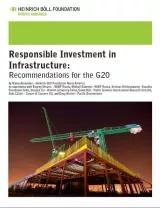Responsible Investment in Infrastructure: Recommendations for the G20
Policy Paper
Responsible Investment in Infrastructure: Recommendations for the G20
This infrastructure development goal was advanced at the Russian G20 Summit in September 2013, where the Leaders adopted:
- the report of the G20’s Study Group (SG) on “Financing for Investment,” which identified three goals for future work, relating to: facilitating project preparation and financing; improving the investment climate; and helping to generate long-term financing for infrastructure investments. The SG, comprised of G20 Finance Ministers addresses the infrastructure investment needs of G20 countries, particularly emerging market economies.
- two reports on the infrastructure needs of low-income countries: the “St. Petersburg Development Outlook” echoes the SG’s call for improving the effectiveness of project preparation facilities (PPFs) (and possibly creating a global network of such facilities) as well as examining the implications for Low-Income Countries of work of the Study Group’s agenda on long-term financing of investment. The St. Petersburg Accountability Report on G20 Development Commitments called for strong follow-up on commitments, including the “stalled” commitment to integrate of environment safeguards in infrastructure work.
Infrastructure is an important component of an overall sustainable development strategy, but we must also ask: What kind of infrastructure is necessary and where? For whose benefit? How should the cost/benefits of infrastructure proposals be assessed? How will proposed infrastructure affect the planet’s carbon footprint? How can investment be brought into underserved countries, or continents, such as Africa? How should infrastructure finance be generated? Are PPPs the right modality for infrastructure development?
Understandably, the G20 has devoted considerable effort to the question of how infrastructure finance should be generated. This paper addresses that question and puts it in a larger context. We encourage infrastructure development that achieves a “triple bottom line” (economic, environmental and social co-benefits) and, to that end, recommend a “value for money” (VFM) approach to infrastructure financing. Used properly, this approach does not create a bias toward public or private financing or toward short- or long- term investment. The VFM approach is defined as “what a government judges to be an optimal combination of quantity, quality, features and price (i.e., cost), expected...over the whole of the project’s lifetime.”
The VFM approach would require the G20 to relinquish its bias in favour of PPPs in order to weigh this approach with alternatives and, thus, ensure optimal benefits to the stakeholders. The VFM approach should be adopted regardless of the volume of resources at the disposal of investors. For instance, large infrastructure projects are often driven by governments (and state-owned enterprises (SOEs)) of emerging market countries with abundant capital, while at other times, they are driven by cash-strapped low-income governments.
More fundamentally, to achieve a “triple bottom line,” the G20’s approach to infrastructure should:
- Reinforce “bottom-up” demand for infrastructure in the context of locally- and nationally-owned strategies. The lessons of experience also stress the importance of standards, or safeguards, for public and private finance, as well as for foreign direct investment (FDI), which can help ensure that infrastructure projects contribute to inclusive and sustainable development. Such standards – relating to information disclosure, transparency, social and environmental principles -- should not represent peripheral “frills,” but rather fundamental components of project identification, design and implementation. Currently, the G20 should resist pressure to diminish standards and compliance with standards and, instead, lead a process of “upward harmonization”.
- Require that new waves of infrastructure development rely on renewable energy so that the global community complies with its commitment to arrest global warming and ensure that global warming does not increase by 2°C by 2100.
- Where appropriate, encourage governments to expand public investment in infrastructure without undermining domestic social spending or taking on excessive fiscal risks (including contingent liabilities) which, if they materialize, could trigger debt distress.
- Recommend that governments put a high priority on developing or acquiring the institutional capacity to: negotiate equitable financial arrangements; provide regulation, especially in the sectors where natural monopolies exist; deliver public goods; and prevent corruption.
When it achieves a “triple bottom line,” investment in sustainable infrastructure development can be considered a “public good,” which boosts commerce while creating jobs and protecting the environment and the rights of local communities.
